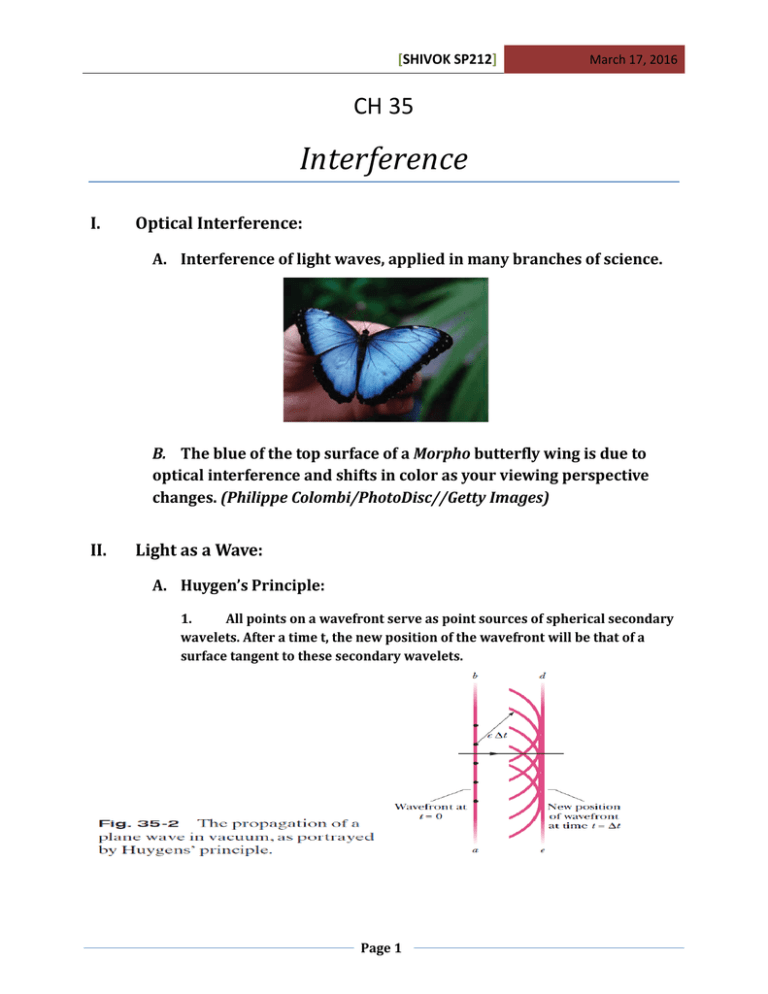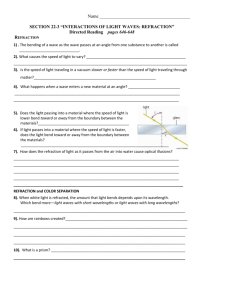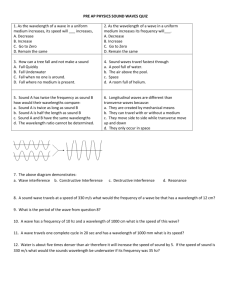Interference CH 35 I. Optical Interference:
advertisement

[SHIVOK SP212] March 17, 2016 CH 35 Interference I. OpticalInterference: A. Interferenceoflightwaves,appliedinmanybranchesofscience. B. TheblueofthetopsurfaceofaMorphobutterflywingisdueto opticalinterferenceandshiftsincolorasyourviewingperspective changes.(PhilippeColombi/PhotoDisc//GettyImages) II. LightasaWave: A. Huygen’sPrinciple: 1. Allpointsonawavefrontserveaspointsourcesofsphericalsecondary wavelets.Afteratimet,thenewpositionofthewavefrontwillbethatofa surfacetangenttothesesecondarywavelets. Page1 [SHIVOK SP212] March 17, 2016 B. LightasaWave,LawofRefraction: 1. Thelawofrefractionstillapplies: 2. Proof: Page2 [SHIVOK SP212] March 17, 2016 C. LightasaWave,WavelengthandLawofRefraction: 1. Thephasedifferencebetweentwolightwavescanchangeifthewaves travelthroughdifferentmaterialshavingdifferentindexesofrefraction. 2. Tofindtheirnewphasedifferenceintermsofwavelengths,wefirst countthenumberN ofwavelengthsthereareinthelengthLofmedium1. 1 3. Similarly,formedium2, 4. Page3 [SHIVOK SP212] March 17, 2016 D. LightasaWave,RainbowsandOpticalInterference 1. Lightwavespassintoawaterdropalongtheentiresidethatfacesthe Sun.Differentpartsofanincomingwavewilltraveldifferentpathswithinthe drop. 2. Thatmeanswaveswillemergefromthedropwithdifferentphases. Thus,wecanseethatatsomeanglestheemerginglightwillbeinphaseand giveconstructiveinterference. 3. Therainbowistheresultofsuchconstructiveinterference. E. SampleProblems: 1. Inthefigurebelow,assumethatthetwolightwaves,of wavelength620nminair,areinitiallyoutofphasebyπrad.The indexesofrefractionofthemediaaren1=1.45andn2=1.65.Whatarethe(a) smallestand(b)secondsmallestvalueofLthatwillputthewavesexactlyin phaseoncetheypassthroughthetwomedia? Page4 [SHIVOK SP212] March 17, 2016 2. Alaserbeamwithawavelengthandfrequencyinairof540nmand 5.6x1014Hzentersafluidwithrefractiveindex1.3atanangleof40ºwith respecttothenormaltothesurface.Thefrequencyandwavelengthofthe lightinthefluidareclosestto Page5 [SHIVOK SP212] March 17, 2016 III. Diffraction: A. Ifawaveencountersabarrierthathasanopeningofdimensions similartothewavelength,thepartofthewavethatpassesthroughthe openingwillflare(spread)out—willdiffract—intotheregionbeyond thebarrier.Theflaringisconsistentwiththespreadingofwavelets accordingtoHuygensprinciple.Diffractionoccursforwavesofall types. B. Awavepassingthroughaslitflares(diffracts). Page6 [SHIVOK SP212] March 17, 2016 C. Young’sInterferenceExperiment: Page7 [SHIVOK SP212] March 17, 2016 1. Thephasedifferencebetweentwowavescanchangeifthewavestravel pathsofdifferentlengths. 2. WhatappearsateachpointontheviewingscreeninaYoung’sdouble‐ slitinterferenceexperimentisdeterminedbythelengthdifferenceLofthe raysreachingthatpoint. 3. Forabrightfringe,Lmustbeeitherzerooranintegernumberof wavelengths.Therefore, 4. Foradarkfringe,Lmustbeanoddmultipleofhalfawavelength. Therefore, 5. Page8 [SHIVOK SP212] March 17, 2016 D. SampleProblems: 1. SupposethatYoung'sexperimentisperformedwithblue‐greenlightof wavelength500nm.Theslitsare1.20mmapart,andtheviewingscreenis 5.40mfromtheslits.Howfarapartarethebrightfringesnearthecenterof theinterferencepattern? Page9 [SHIVOK SP212] March 17, 2016 2. AYoung’sinterferenceexperimentisperformedwith monochromaticlightofwavelength632.8nm.Intheinterferencepattern onascreen3.0mawayfromtheslits,thesecondminimumis5mmaway fromthecenterofthepattern.Theseparationbetweentheslitsisclosest to Page 10 [SHIVOK SP212] March 17, 2016 3. Monochromaticlightofwavelength537nmstrikesascreencontaining 2slitsthatare5.0μmapartand2.0mfromaviewingscreen.Whatisthe distanceonthescreenfromthecenteroftheinterferencepatterntothe secondordermaximum? 4. Adouble‐slitarrangementproducesinterferencefringesforsodium light(λ=589nm)thatare0.20°apart.Whatistheangularfringeseparationif theentirearrangementisimmersedinwater(n=1.33)? Page 11 [SHIVOK SP212] March 17, 2016 E. Coherence: 1. FortheinterferencepatterntoappearonviewingscreenCinthe figure,thelightwavesreachinganypointPonthescreenmusthaveaphase differencethatdoesnotvaryintime.Whenthephasedifferenceremains constant,thelightfromslitsS andS issaidtobecompletelycoherent. 1 2 2. Ifthelightwavesconstantlychangeintime,thenthelightissaidtobe incoherent. Page 12 [SHIVOK SP212] March 17, 2016 IV. InterferencefromThinFilms: A. Theinterferencedependsonthereflectionsandthepathlengths: B. Thephasedifferencebetweentwowavescanchangeifoneor bothwavesarereflected. Page 13 [SHIVOK SP212] March 17, 2016 C. InterferencefromThinFilms,ReflectionPhaseShifts: 1. Forlight,whenanincidentwavetravelinginthemediumofgreater indexofrefractionnisreflectedattheinterfaceseparatingthesecond mediumofsmallerrefractiveindex,thereflectedwavedoesnotundergoa changeinphase;thatis,itsreflectionphaseshiftiszero. 2. Whenawavetravelinginamediumofsmallerindexofrefractionis reflectedattheinterfaceseparatingthesecondmediumofahigherrefractive index,thephasechangeisrad,orhalfawavelength. D. Giventhebelowdrawing: 1. Atpointaonthefrontinterface,theincidentwave(inair)reflectsfrom themediumhavingthehigherofthetwoindexesofrefraction;sothewaveof reflectedrayr hasitsphaseshiftedby0.5wavelength. 1 2. Atpointbonthebackinterface,theincidentwavereflectsfromthe medium(air)havingthelowerofthetwoindexesofrefraction;thewave reflectedthereisnotshiftedinphasebythereflection,andthusneitheristhe portionofitthatexitsthefilmasrayr . 2 3. Ifthewavesofr andr aretobeexactlyinphasesothattheyproduce 1 2 fullyconstructiveinterference,thepathlength2Lmustcauseanadditional phasedifferenceof0.5,1.5,2.5,…wavelengths. Page 14 [SHIVOK SP212] March 17, 2016 4. If,instead,thewavesaretobeexactlyoutofphasesothatthereisfully destructiveinterference,thepathlength2Lmustcauseeithernoadditional phasedifferenceoraphasedifferenceof1,2,3,...wavelengths. But 5. Therefore: E. InterferencefromThinFilms,EquationsSummary: Note: You must draw the thin film diagram to figure out which equation to use!!!! Page 15 [SHIVOK SP212] March 17, 2016 F. InterferencefromThinFilms,Filmthicknessmuchlessthan: G. SampleProblems(includingpracticedrawingthinfilmdiagram): 1. Lightofwavelength624nmisincidentperpendicularlyonasoapfilm (n=1.33)suspendedinair.Whatarethe(a)leastand(b)secondleast thicknessesofthefilmforwhichthereflectionsfromthefilmundergofully constructiveinterference? Page 16 [SHIVOK SP212] March 17, 2016 SampleProblems(continued): 2. Aplanewaveofmonochromaticlightisincidentnormallyonauniform thinfilmofoilthatcoversaglassplate.Thewave‐lengthofthesourcecanbe variedcontinuously.Fullydestructiveinterferenceofthereflectedlightis observedforwavelengthsof500and700nmandfornowavelengthsin between.Iftheindexofrefractionoftheoilis1.30andthatoftheglassis1.50, findthethicknessoftheoilfilm. Page 17 [SHIVOK SP212] March 17, 2016 SampleProblems(continued): 3. Inthefigurebelow,twomicroscopeslidestouchatoneendandare separatedattheotherend.Whenlightofwavelength500nmshinesvertically downontheslides,anoverheadobserverseesaninterferencepatternonthe slideswiththedarkfringesseparatedby1.2mm.Whatistheanglebetween theslides? Page 18 [SHIVOK SP212] March 17, 2016 V. Michelson’sInterferometer: A. Experiment: B. IfthematerialhasthicknessLandindexofrefractionn,thenthe numberofwavelengthsalongthelight’sto‐and‐fropaththroughthe materialis C. Thenumberofwavelengthsinthesamethickness2Lofairbefore theinsertionofthematerialis D. Whenthematerialisinserted,thelightreturnedfrommirrorM1 undergoesaphasechange(intermsofwavelengths)of Page 19 [SHIVOK SP212] March 17, 2016 E. Foreachphasechangeofonewavelength,thefringepatternis shiftedbyonefringe.Thus,bycountingthenumberoffringesthrough whichthematerialcausesthepatterntoshift,onecandeterminethe thicknessLofthematerialintermsofl. F. SampleProblem: 1. IfmirrorM2inaMichelsoninterferometer(Fig.35‐21)ismovedthrough 0.233mm,ashiftof792brightfringesoccurs.Whatisthewavelengthofthe lightproducingthefringepattern? Page 20






